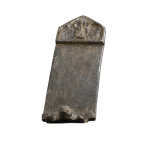
Miniature Stele
Location Karakorum
Dating 13th-14th cent.
Epoch Mongolian empire
Material Bronze
Technique Cast
Type Excavation find
Description
Depicted is a small stele with a turtle base. The upper part of the stele has a frame with a triangular top and a square base, and in this frame Buddha is depicted sitting on his throne. The elongated rectangular space from the upper part with a depiction of the Buddha to the base of the turtle is left blank, and perhaps some kind of writing on paper was pasted into this part. The base of the statue – only the outline of the turtle’s head and chest. The base is not flat and therefore cannot be placed on its own. The back of the statue is solid and a semi-circular metal hook is welded in the middle. Judging by the wooden remains on the back, the statue was attached to a wooden object.
The stele is a miniature of what such memorial steles looked like in China at the time. Inscription steles were erected on a turtle as a foundation. They were used both to commemorate the dead of important personalities and to commemorate foundations, edicts and other important events. The most prominent example of such an inscription erected in stone is the Karakorum inscription on the Great Hall. This commemorates the construction and renovation of this great state temple.
3D Visualisation
3D Model: C. Mackenzie / DAI
Images: H. Rohland / DAI
Literature
Janßen-Kim, M. (2005) ‘Miniaturstele’, in Dschingis Khan und seine Erben: Das Weltreich der Mongolen. München: Hirmer, p. 176.

